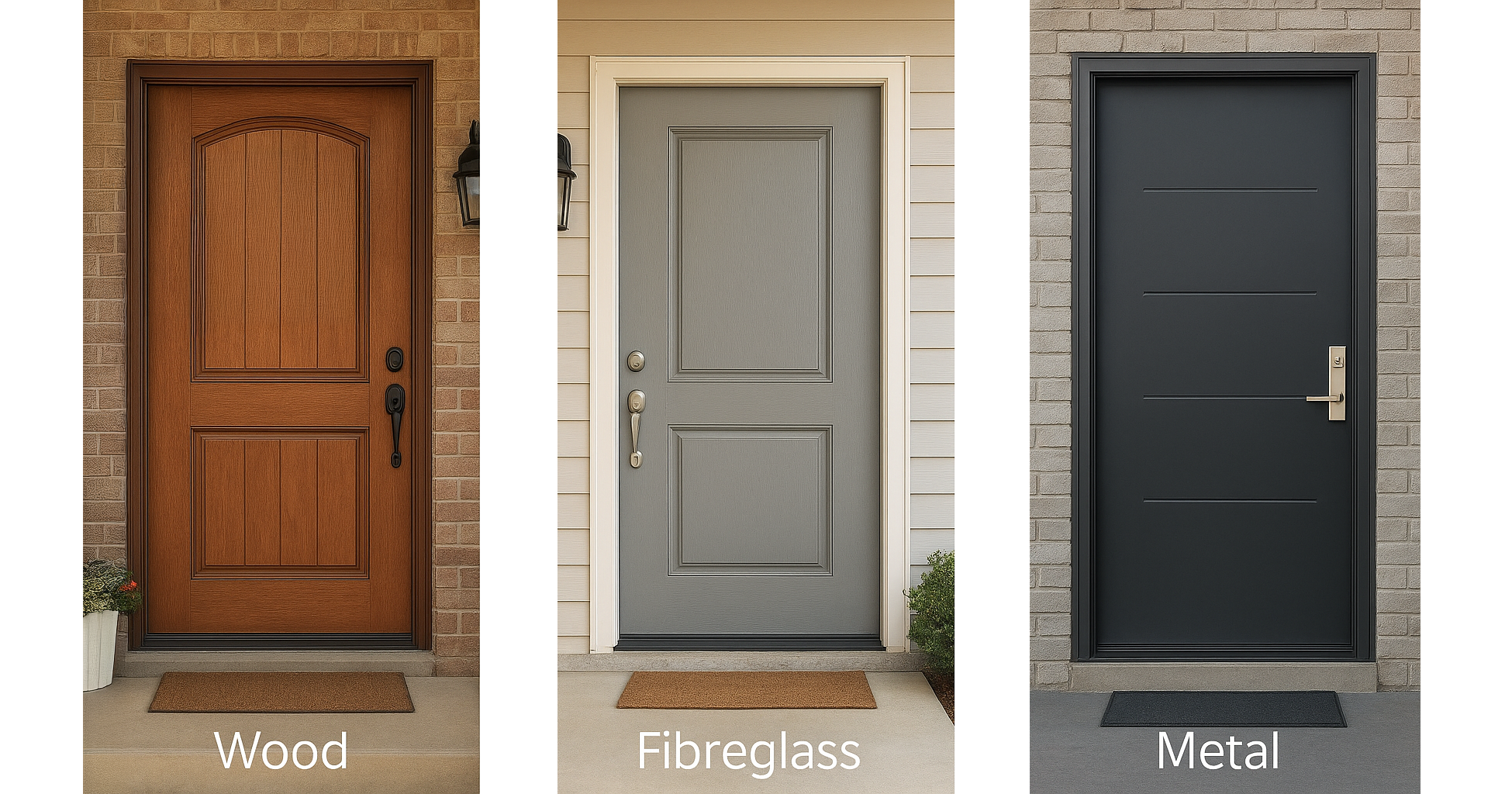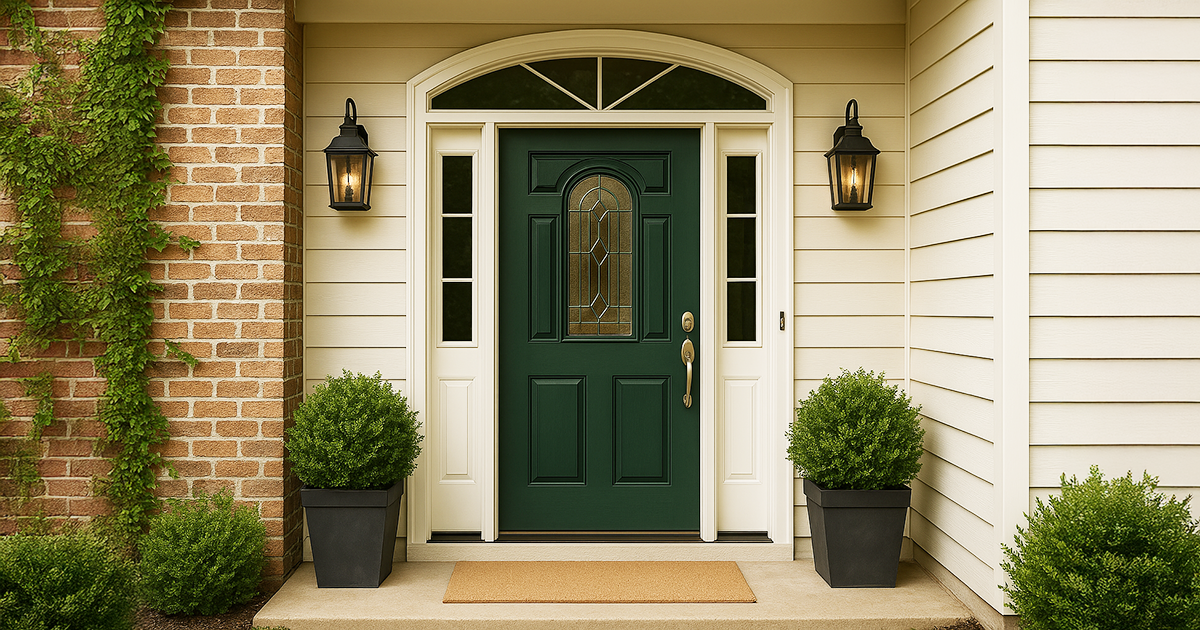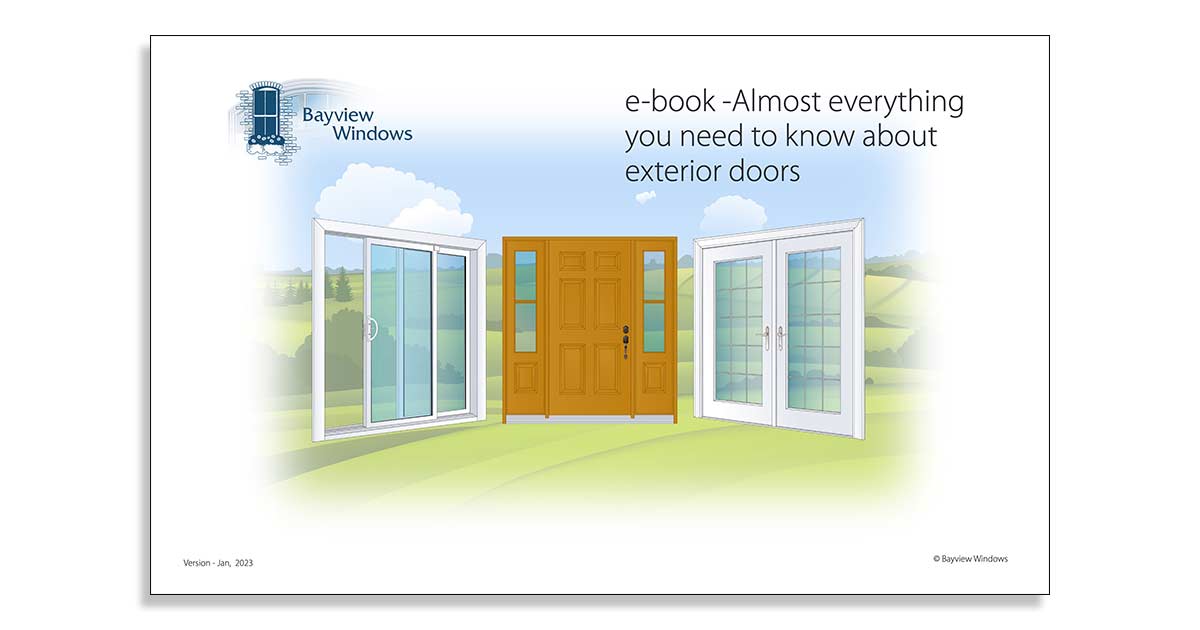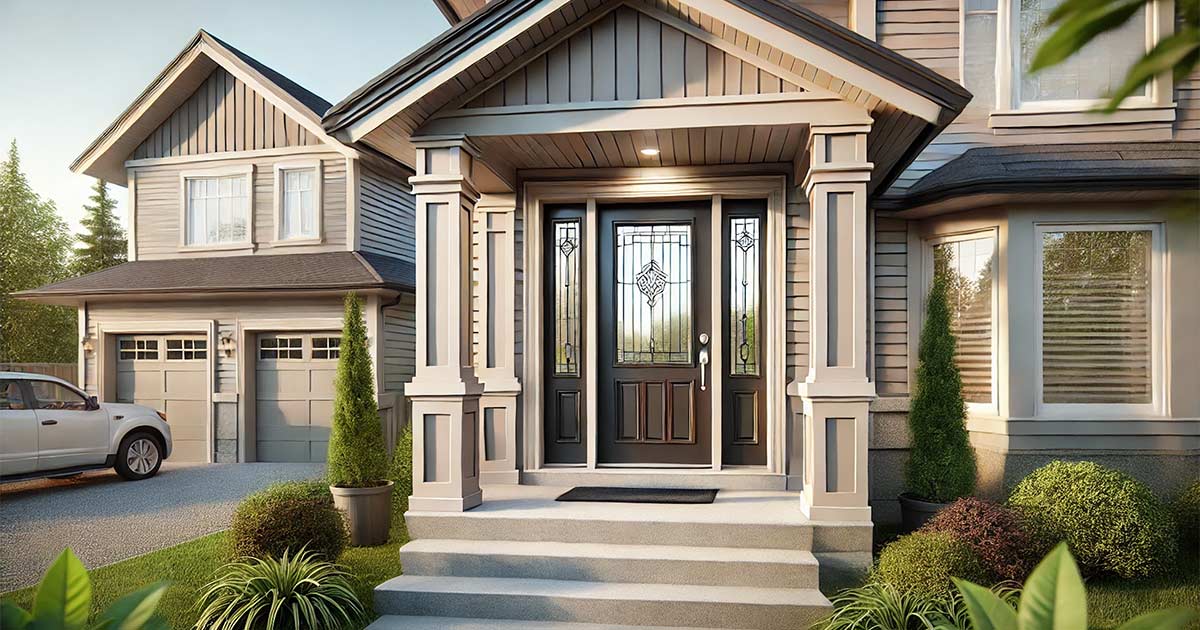Insights > Article > Posted: 2025-Aug-13, Updated: 2026-Jan-13
Door Materials: Fiberglass vs Steel vs Wood Entrance Doors

This guide compares four popular entrance door materials, fibreglass, steel, vinyl, and wood, to help you make an informed decision.
In this article:
If you're a homeowner in Ottawa or the surrounding region, this guide will help you compare materials and decide which option makes the most sense for your climate, budget, and home style.
Material & Construction
Fibreglass Entrance Doors
Fibreglass doors are constructed with reinforced fibreglass skins over a solid, insulated core, often polyurethane. These doors are engineered to replicate the look of real wood without the associated maintenance issues, offering strength, security, and longevity.
Steel Entrance Doors
Steel doors feature a steel skin, typically galvanised, over an insulated foam core. They provide excellent strength and security at a lower cost than fibreglass or wood, making them a popular choice for homeowners seeking durability on a budget.
Vinyl Entrance Doors
Vinyl doors are made from uPVC (unplasticised polyvinyl chloride), a lightweight and budget-friendly material. They are often used for side or back doors and may be combined with glass or steel components. While resistant to moisture, their design options are limited compared to other materials.
Wood Entrance Doors
Wood doors are crafted from solid wood or wood veneers over engineered cores. They offer unmatched beauty and craftsmanship but require significant maintenance to stay in good condition, making them best suited for protected entryways.
Tip: For strength and longevity in Ottawa’s climate, fibreglass and steel are top contenders. Wood is beautiful but high-maintenance, and vinyl is best reserved for lower-use entrances.
Appearance & Style Options
Fibreglass Entrance Doors
Fibreglass doors are highly versatile, and can be stained to mimic real wood grain or painted in bold colours, with many styles to suit both modern and traditional homes.
Steel Entrance Doors
Steel doors are typically smooth and painted, though some can be embossed with wood-like textures. Style options are expanding but still limited compared to fibreglass.
Vinyl Entrance Doors
Vinyl doors have limited colour and design flexibility, usually smooth basic finishes like white or beige, making them less ideal for statement-making front entrances.
Wood Entrance Doors
Wood doors are the most customisable, allowing for stain, carving, or paint for unique finishes, suitable for historic homes or premium custom builds.
Tip: If you want a wood-look door with less upkeep, opt for fibreglass. If you prefer a true custom design and don’t mind the maintenance, wood is the best choice.
Durability & Performance in Ottawa’s Climate
Fibreglass Entrance Doors
Fibreglass offers excellent resistance to dents, warping, cracking, and moisture, and withstands Ottawa’s temperature swings, snow, and humidity.
Steel Entrance Doors
Steel is very strong and secure, but can dent or rust if the paint finish is damaged, performing well in harsh weather if properly protected.
Vinyl Entrance Doors
Vinyl is resistant to moisture but can become brittle in extreme cold, and UV exposure may cause fading or slight warping over time.
Wood Entrance Doors
Wood can swell, crack, or rot with exposure to moisture or poor maintenance, and is not ideal for exposed, weather-facing entries in Ottawa.
Tip: For worry-free year-round performance in Ottawa, fibreglass leads the pack, followed by properly protected steel.
Energy Efficiency
Fibreglass Entrance Doors
Fibreglass provides excellent insulation due to its thick foam core and tight-fitting seals, helping reduce heating and cooling costs.
Steel Entrance Doors
Steel is also highly energy-efficient when insulated with a quality foam core, slightly less thermally stable than fibreglass but still very effective.
Vinyl Entrance Doors
Vinyl offers decent insulation but may not match the efficiency of fibreglass or steel doors.
Wood Entrance Doors
Wood provides natural insulation but may lack the consistency and efficiency of modern insulated doors.
Tip: For optimal energy efficiency in Ottawa’s climate, consider fibreglass or steel doors with high-quality insulation.
Maintenance & Longevity
Fibreglass Entrance Doors
Fibreglass requires occasional cleaning and may need repainting over time. It won’t rust, rot, or peel. A stained fibreglass door may need occasional clear coat touch-ups.
Steel Entrance Doors
Steel requires low to moderate maintenance, and touch-ups may be necessary to prevent rust and maintain appearance.
Vinyl Entrance Doors
Vinyl requires minimal maintenance, though occasional cleaning is recommended to remove dirt and stains..
Wood Entrance Doors
Wood requires high maintenance, including regular sealing or painting to protect against weather-related damage.
Tip: For minimal upkeep, fibreglass or vinyl doors are ideal, and if you prefer wood, be prepared for regular maintenance.
Security
Fibreglass Entrance Doors
Fibreglass doors are known for their solid core construction, making them highly resistant to forced entry. Many models come with reinforced frames and advanced locking options, offering excellent security for your home. While fibreglass itself is not fire-rated, some doors can be specially certified to meet fire safety standards if required.
Steel Entrance Doors
Steel doors are among the most secure options on the market due to their heavy-gauge metal construction. They are very difficult to break through, making them ideal for homeowners prioritising safety. Additionally, steel doors often come with fire-rated options, providing an extra layer of protection and peace of mind.
Vinyl Entrance Doors
Vinyl doors generally provide basic security but are less robust compared to fibreglass or steel. Because of their lighter construction, vinyl doors are more vulnerable to forced entry and rarely carry fire safety ratings. They are best used in secondary entrances or low-risk areas.
Wood Entrance Doors
Wood doors offer moderate security depending on their thickness and core material. Solid hardwood doors can be strong, but wood is more susceptible to damage from force and fire. Fire ratings for wood doors vary widely, and special fire-rated wood doors are available for added protection.
Tip: If security and fire safety are priorities, steel doors are usually your best bet, followed by fibreglass models with reinforced cores and certified fire ratings. Always check product specifications to ensure they meet your local building code and insurance requirements.
Cost Considerations
Fibreglass Entrance Doors
Mid-to-high price range, but offers exceptional long-term value thanks to energy savings and durability.
Steel Entrance Doors
Typically, the most affordable material. A great choice for budget-conscious homeowners who still want solid performance.
Vinyl Entrance Doors
Low-cost option, usually reserved for secondary doors or basic entry systems.
Wood Entrance Doors
Most expensive upfront and over time (due to maintenance), but adds unmatched beauty and curb appeal.
Tip: If you're planning to stay in your home long-term, fibreglass or steel offers the best return on investment. Use wood for curb appeal in prestige projects.
Popularity & Warranty Insights
Most Popular Choice
Fibreglass doors are now the most popular for front entrances in Canada due to their durability, energy efficiency, and design versatility.
Best Warranties
Fibreglass and steel doors typically carry the best warranties, often 20 years or more on structure, finish, and glass. Vinyl doors offer moderate warranties, usually 10–15 years, sometimes prorated. Wood doors have the shortest and most conditional warranties, typically 5–10 years, and require strict maintenance to remain valid.
Tip: Always read the fine print on warranties. A longer warranty usually means a more durable, trusted product.
Additional Consumer Considerations
Sound Insulation
Many homeowners care about how well their door blocks outside noise. Fibreglass and solid-core steel doors typically provide good sound insulation, whereas vinyl and thinner wood doors might let more noise through.
Environmental Impact & Sustainability
Some buyers look for doors made from sustainable materials or those that have a smaller carbon footprint. Wood doors from responsibly managed forests or fibreglass doors with recyclable components can appeal to eco-conscious consumers.
Installation Complexity & Cost
Door installation can vary significantly depending on the material. Fibreglass and steel doors may require professional installation due to weight and frame requirements, while vinyl and some wood doors might be easier to install as DIY projects.
Weather Resistance & Warranty on Finish
Consumers want doors that can withstand sun, rain, snow, and freeze-thaw cycles without fading, peeling, or warping. Warranty length and coverage on finishes are crucial here—fibreglass and steel often have the best warranties.
Impact Resistance
Steel resists heavy impacts, fibreglass endures knocks with ease, wood is prone to dents, and PVC handles everyday bumps.
Resale Value & Curb Appeal
The right door can boost a home’s curb appeal and resale value. High-end fibreglass and wood doors often add more perceived value, while steel offers solid security appeal at a lower cost.
Quick Comparison
Fibreglass
Steel
Vinyl
Wood
Final Thoughts
Choosing the right entrance door material depends on your specific needs, budget, and personal preferences:
Fibreglass is ideal for homeowners seeking durability, low maintenance, and energy efficiency, performing well in Ottawa’s climate, Steel is suitable for those prioritising security and affordability, requiring proper maintenance to prevent rust, Vinyl is best for budget-conscious homeowners looking for low-maintenance options for side or back entrances, Wood is perfect for those desiring a traditional, custom look and willing to invest time in maintenance.
By considering these factors, Ottawa homeowners can select the entrance door that enhances curb appeal, security, energy efficiency, and long-term comfort.
Related articles
Don’t settle for guesswork
Discover the entrance door that’s perfect for your home, style, and budget. Book your free, no-obligation consultation today and let our experts bring your vision to life.



